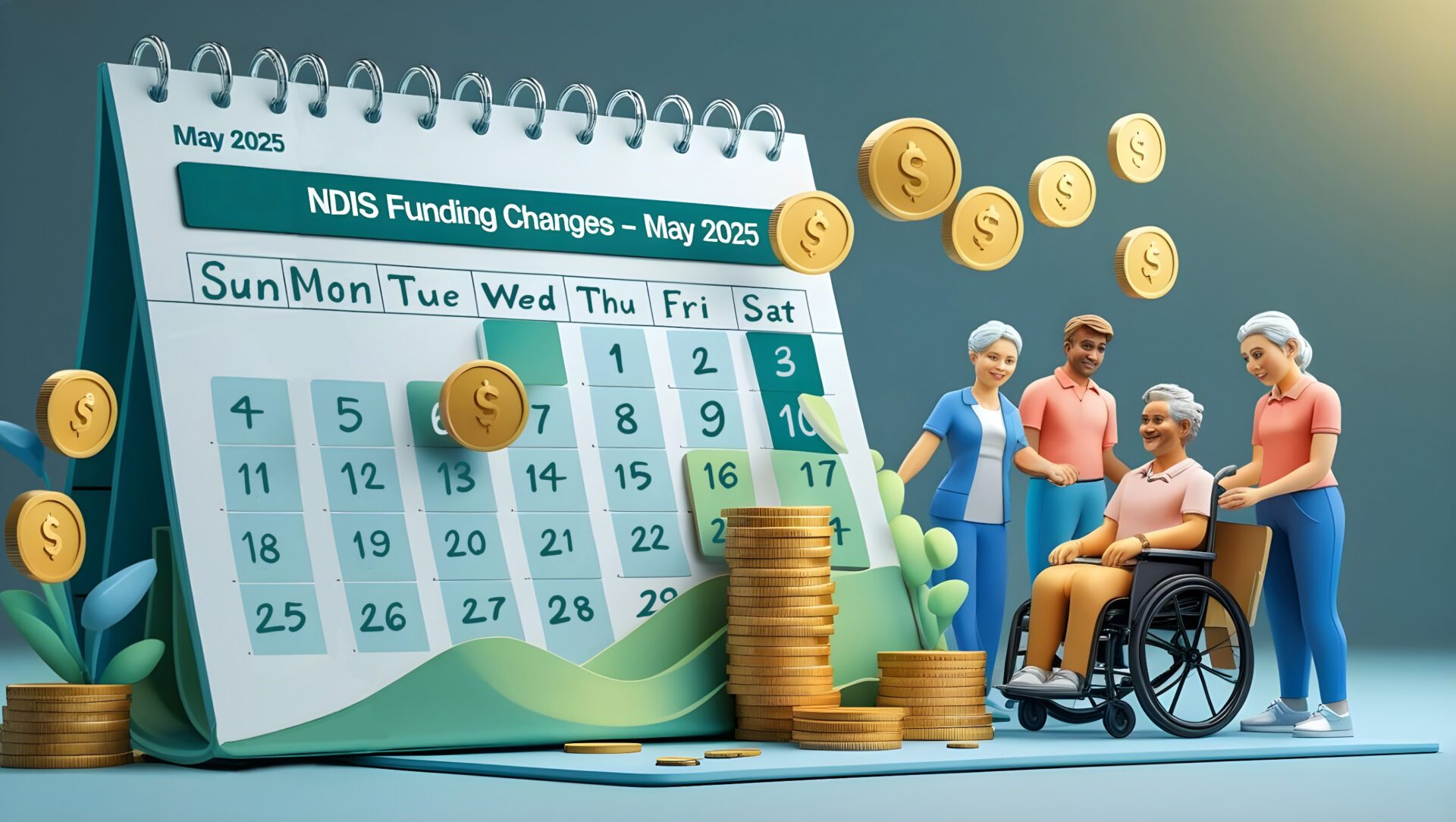Estimated reading time: 7 minutes
As an NDIS participant or carer, understanding how your funding works is crucial to getting the most out of your plan. The National Disability Insurance Agency (NDIA) is introducing significant changes to how funding is distributed, starting May 19, 2025. These updates to NDIS funding periods will affect how you access and manage your support throughout the year.
At The SALT Foundation, we’re committed to helping our Melbourne community understand these changes and prepare for a smoother transition. Whether you’re based in Frankston, the Mornington Peninsula, or elsewhere in Victoria, this guide will walk you through everything you need to know about the new NDIS funding period structure.
Table of Contents
- Key Takeaways
- What Are NDIS Funding Periods?
- Who Will Be Affected by the Changes?
- How NDIS Funding Periods Will Work
- Why Is the NDIA Making These Changes?
- What Happens to Unused Funds?
- Special Considerations for Different Support Types
- Factors That Determine Your Funding Period Schedule
- How to Track and Manage Your Budget
- What to Do If You Run Out of Funds Early
- How to Prepare for the Changes
- How Salt Foundation Can Help
- Conclusion
- Action Steps
- Frequently Asked Questions
Key Takeaways
- NDIS funding periods will change from May 19, 2025, affecting all new and reassessed plans
- Instead of receiving your entire budget upfront, funding will typically be released quarterly (every 3 months)
- Total plan funding remains unchanged – only the timing of access changes
- Unused funds roll over within the same plan but not to new plans
- Different support categories may have different funding period schedules (monthly, quarterly, semi-annually, or annually)
- The changes aim to prevent early overspending and promote more consistent support throughout the plan
What Are NDIS Funding Periods?
Funding periods are specific timeframes during which portions of your NDIS funding become available for use. Starting May 19, 2025, instead of receiving your entire annual budget at once, you’ll access your funding in scheduled instalments, typically every three months.
This change follows the Section 33 legislative amendments passed in October 2024, which gave the NDIA authority to group supports into funding components and release budgets in structured periods.
To be clear: these changes don’t affect how much funding you receive, only when you can access it.
Who Will Be Affected by the Changes?
The new funding period structure will apply to:
- All new NDIS participants from May 19, 2025
- Current participants at their next scheduled plan reassessment
If you’re on an existing plan, nothing changes until your next review or reassessment. The implementation will be gradual rather than immediate, giving everyone time to adapt.
How NDIS Funding Periods Will Work
Your NDIS planner or delegate will determine your funding period schedule based on your individual needs, goals, and support requirements. The typical funding period options include:
- Monthly: 12 funding periods per year
- Quarterly: 4 funding periods per year (most common)
- Semi-annually: 2 funding periods per year
- Annually: 1 funding period per year
What’s particularly important to understand is that different support categories within your plan may have different funding period schedules.
Example Plan Breakdown
To illustrate how this works, let’s look at a 12-month plan starting on May 19, 2025:
- Core Supports: $80,000 released over 4 quarterly funding periods
- Home and Living: $120,000 released over 12 monthly funding periods
- Improved Daily Living: $30,000 released in 1 annual funding period
In the first month (May), you would receive:
- $20,000 for Core Supports
- $10,000 for Home and Living
- $30,000 for Improved Daily Living
Then in June, you would only receive $10,000 for Home and Living, as the other categories follow different schedules.
Why Is the NDIA Making These Changes?
The NDIA is introducing funding periods in response to feedback from participants, families, providers, and financial advocates. Common challenges with the previous model included:
- Overspending early in the plan period
- Inconsistent access to supports throughout the year
- Financial stress for those managing complex plans
- Risk of fund misuse or accidental overspending
By introducing shorter, more structured funding periods, the NDIA aims to:
- Support better budgeting habits
- Promote more consistent service delivery
- Reduce financial stress
- Protect participants from potential financial misuse
- Enhance oversight for participants with complex needs
What Happens to Unused Funds?
A common question about the new system is what happens to funding that isn’t used within a period. Here’s how it works:
- Unused funds roll over to the next funding period within the same plan
- However, unused funds will NOT roll over into a new plan once your current plan expires
- This makes it essential to use your funding strategically throughout your plan’s duration
Special Considerations for Different Support Types
The NDIA recognizes that some supports require different funding approaches:
Large Upfront Costs
For supports like assistive technology or home modifications that require significant upfront investment, you may receive higher initial funding allocations to cover these costs.
Regular High-Cost Supports
Supported Independent Living (SIL) and other regular, high-cost supports will typically follow monthly funding periods to better match service delivery patterns and ensure consistent support.
Factors That Determine Your Funding Period Schedule
The NDIA will consider several factors when deciding your funding period structure:
- Your personal budgeting preferences
- Past funding usage patterns
- Whether funds have been used appropriately
- Presence of risk factors (potential for financial exploitation)
- Complexity of your supports
- Your capacity for self-management
- Whether you use a plan manager or support coordinator
How to Track and Manage Your Budget

With the new funding period structure, keeping track of your budget becomes even more important. The NDIA has improved tools to help you monitor your funding in real time:
- NDIS plan documents
- My NDIS app
- NDIS participant portal
These tools allow you to view your total plan funding, track spending, and see when your next funding period begins.
What to Do If You Run Out of Funds Early
If you exhaust your funds before the end of a funding period, you won’t be able to access more until the next period begins. In this situation:
- Contact your plan manager or support coordinator immediately
- Discuss your situation with the NDIA
- Review your spending patterns and support needs
- Consider requesting a plan reassessment if your circumstances have changed significantly
How to Prepare for the Changes
If you’re approaching a plan review or are new to the NDIS, here are steps to prepare for the funding period changes:
- Speak with your support coordinator about how the changes will affect your specific plan
- Review your current spending patterns to identify if shorter funding cycles might benefit you
- Download the my NDIS app for easy access to your plan and budget information
- Understand what the NDIS can and cannot fund to avoid errors
- Create a support schedule that aligns with your funding periods
- Consider how service agreements might need adjustment to reflect funding availability
How Salt Foundation Can Help
At Salt Foundation, we understand that NDIS funding changes can feel overwhelming, but you don’t have to manage them alone. Our experienced team is here to:
- Explain Your Funding: We break down funding periods, so you know exactly when and how your supports are paid.
- Maximise Your Plan: We help you make the most of your Core Supports, Home and Living, and Improved Daily Living funding.
- Personal Support: We work alongside you, your family, and your plan manager to make sure your plan fits your goals and lifestyle.
- Ongoing Guidance: As NDIS guidelines and funding release schedules change, we keep you informed and supported every step of the way.
- Salt Foundation’s goal is to help you feel confident, informed, and empowered to use your NDIS funding to live your best life.
Conclusion
The introduction of NDIS funding periods represents a significant shift in how participants access and manage their support. While change can be challenging, these updates aim to create a more sustainable system that helps participants maintain consistent access to support throughout their plan.
By understanding how funding periods work and preparing accordingly, you can continue to receive the right support when you need them, making the most of your NDIS plan.
Action Steps
- Check your plan review date to understand when these changes might affect you
- Schedule a meeting with your support coordinator to discuss the implications for your specific situation
- Start tracking your current spending to identify patterns and prepare for the transition
- Update your knowledge about what the NDIS can and cannot fund
- Consider whether you need additional support with budget management
Frequently Asked Questions
No, your total plan funding remains the same. The only change is how and when you can access your funds throughout the plan duration.
For large upfront costs like assistive technology or home modifications, the NDIA may provide higher initial funding allocations. Discuss your specific needs during your planning meeting.
Yes, claims can still be made for services in earlier funding periods if those funds remain available. However, providers are encouraged to submit claims promptly.
Your funding period schedule will be clearly outlined in your NDIS plan document. You can also track this information through the my NDIS app and participant portal.
If your circumstances change significantly (such as increased care needs or health issues), you can request a plan reassessment. Contact your support coordinator or the NDIA directly to discuss your situation.

Temitope Isola is an NDIS content specialist and freelance writer. She works as a freelance writer, focusing especially on the NDIS and mental health space. Her goal is simple: to help service providers speak clearly and genuinely to the people they care for. When she writes, she always keeps the reader’s needs at the forefront of her mind.

